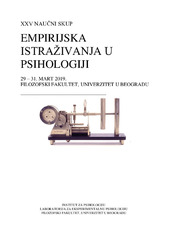| dc.description.abstract | Professionals who are working with refugees are on a daily basis faced with people who have
experienced severe traumatic experiences and, therefore, are subjected to secondary
traumatization. Secondary traumatization comprises of typical trauma-related symptoms
usually seen in trauma survivors suffering from PTSD. The aim of this study was the
examination of the latent structure of coping mechanisms in a sample of professionals working
with refugees in Serbia and the exploration of relations between coping mechanisms and
secondary trauma symptoms. A total of 270 participants (57% females, age range from 18 to
67 (M = 33.66, SD = 9.58) working directly with refugees completed COPE inventory
assessing 15 coping mechanisms and Secondary Traumatic Stress Scale (α = .916) measuring
intrusions (α = .766), avoidance (α = .809), and arousal symptoms (α = .818) of secondary
trauma. Factor analysis of COPE inventory (Maximum likelihood extraction, Promax rotation)
has shown that coping mechanisms group around four inter-related latent factors which
accounted for 46.92% of variance – Problem-focused coping (planning, active coping,
suppression competing activities, and positive reinterpretation and growth), Emotion-focused
coping (use of emotional social support, use of instrumental social support, and focus on
distress and venting of emotions), Avoidant coping (denial, religious coping, and behavioral
disengagement), and Passive coping (acceptance, humor, substance use, restraint, and mental
disengagement). Problem- and emotion-focused coping have shown not to be related to any of
the secondary trauma symptoms. On the other hand, Avoidant coping was related to intrusions
(r = .282, p < .001), avoidance (r = .290, p < .001), and arousal (r = .261, p < .001). The same
pattern of correlations was observed for Passive coping (intrusions r = .129, p < .05; avoidance
r = .232, p < .001; arousal r = .208, p < .001). Results have shown that employing maladaptive
coping mechanisms in order to reduce negative effects of emotionally charged and demanding
work experiences lead to the increase of secondary trauma symptoms, disabling one to deal
with traumatic contents they were faced with. On the other hand, the use of adaptive coping
mechanisms seems not to be effective in terms of alleviation of secondary trauma symptoms.
Obtained results provide valuable guidelines for designing and delivering programs oriented
toward enhancing the well-being of professionals working with traumatized individuals. | sr |

